Australian Tax | Taxation Law | Assignment
VerifiedAdded on 2022/08/26
|7
|1292
|15
AI Summary
Contribute Materials
Your contribution can guide someone’s learning journey. Share your
documents today.
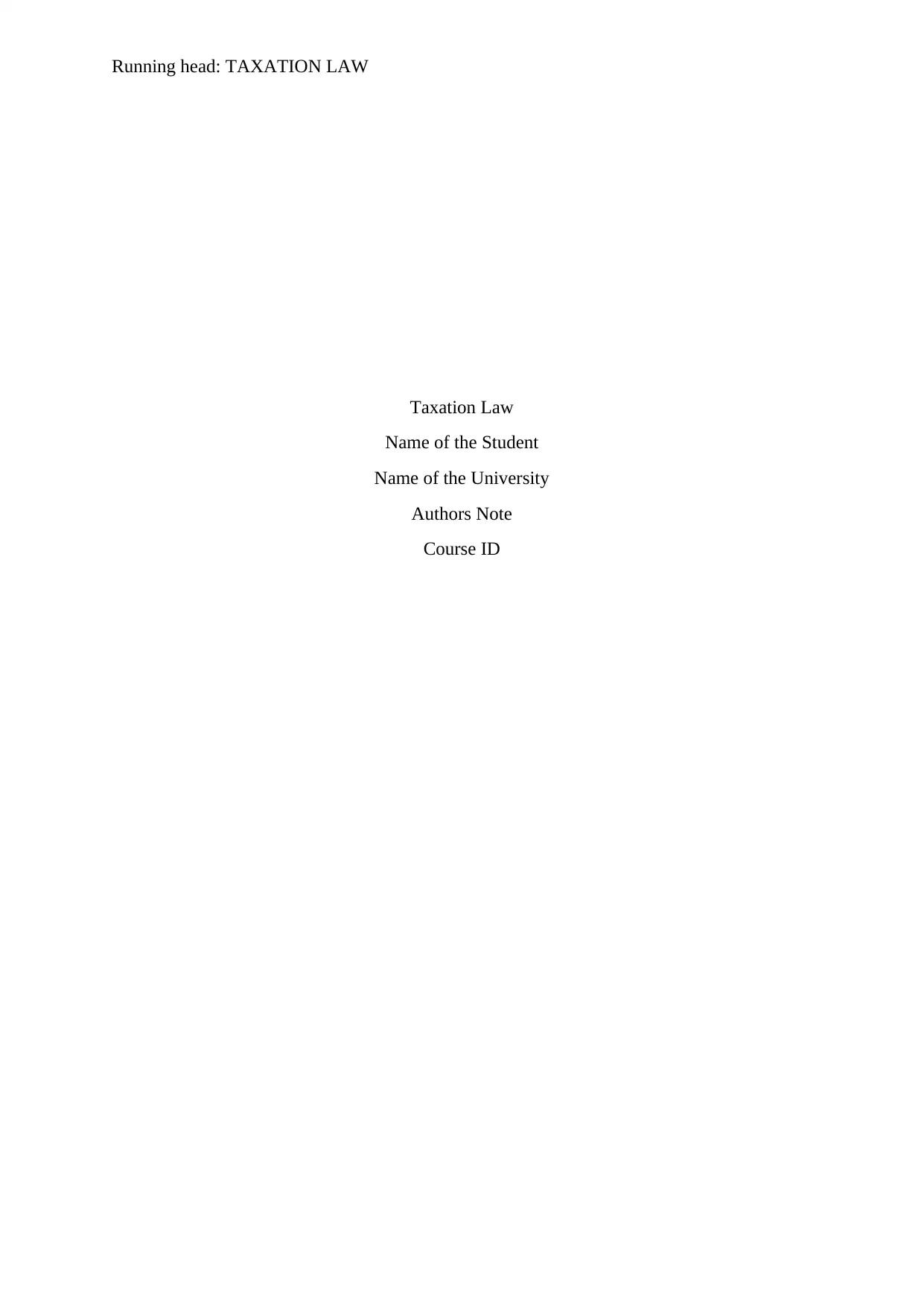
Running head: TAXATION LAW
Taxation Law
Name of the Student
Name of the University
Authors Note
Course ID
Taxation Law
Name of the Student
Name of the University
Authors Note
Course ID
Secure Best Marks with AI Grader
Need help grading? Try our AI Grader for instant feedback on your assignments.
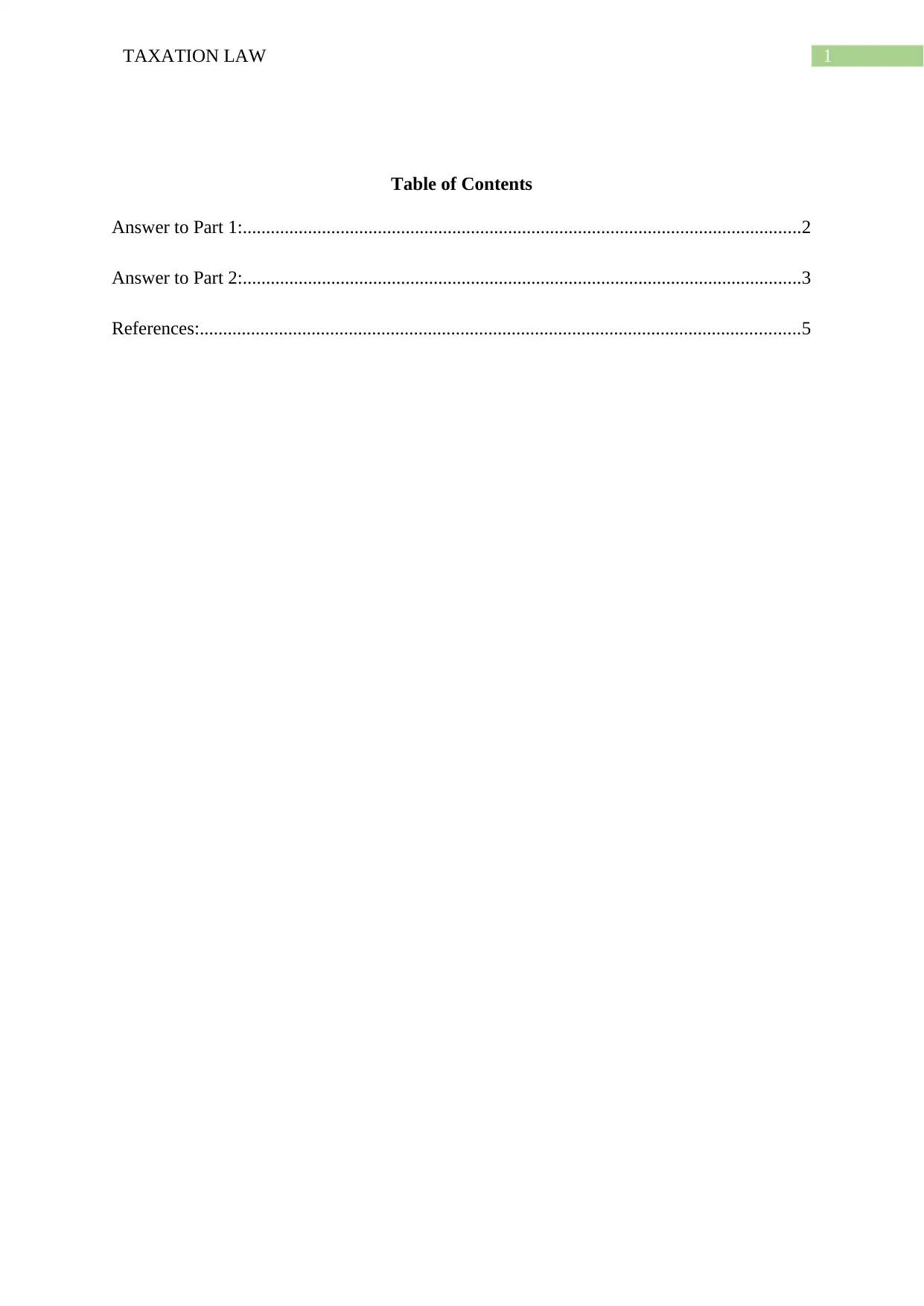
1TAXATION LAW
Table of Contents
Answer to Part 1:........................................................................................................................2
Answer to Part 2:........................................................................................................................3
References:.................................................................................................................................5
Table of Contents
Answer to Part 1:........................................................................................................................2
Answer to Part 2:........................................................................................................................3
References:.................................................................................................................................5
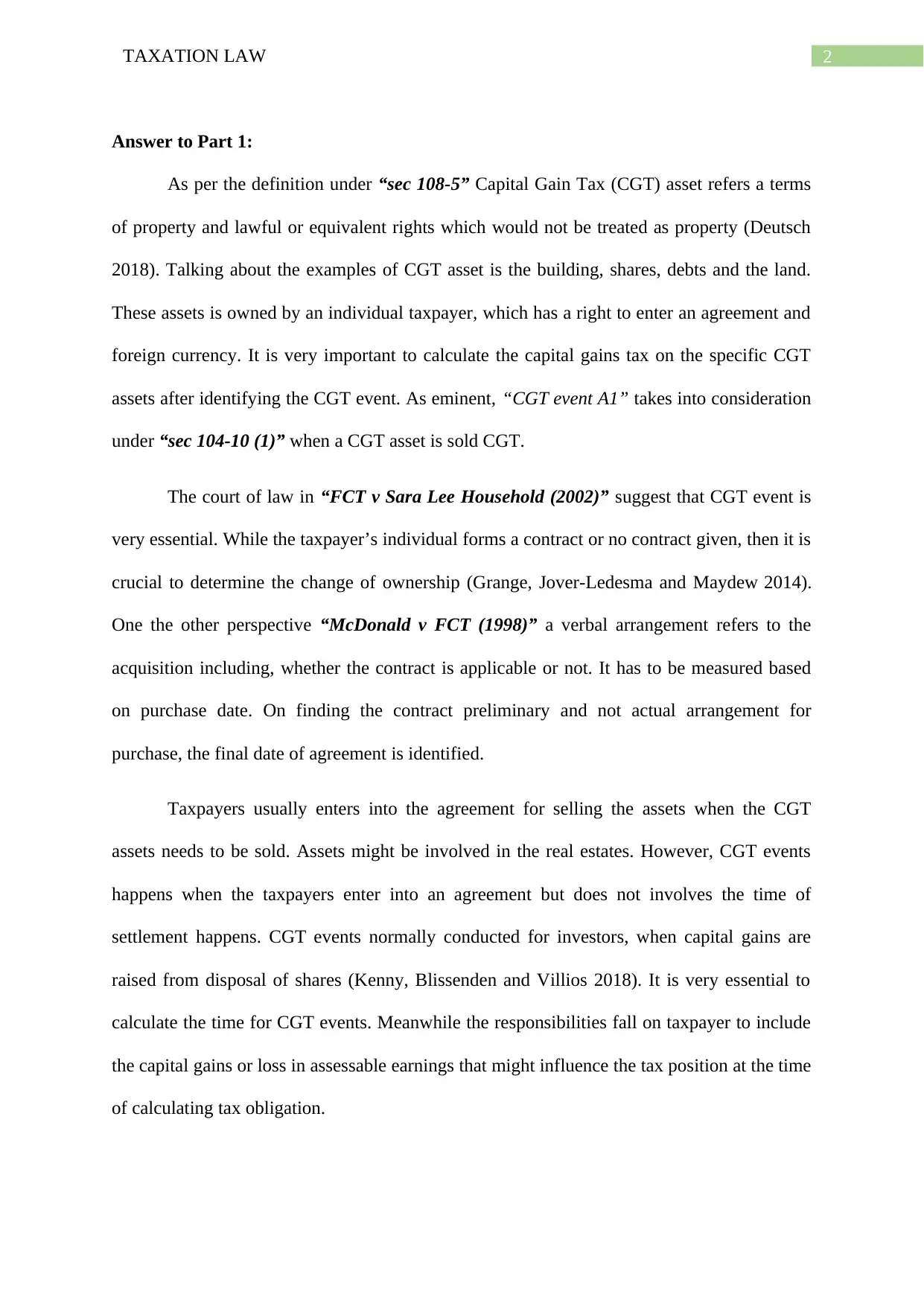
2TAXATION LAW
Answer to Part 1:
As per the definition under “sec 108-5” Capital Gain Tax (CGT) asset refers a terms
of property and lawful or equivalent rights which would not be treated as property (Deutsch
2018). Talking about the examples of CGT asset is the building, shares, debts and the land.
These assets is owned by an individual taxpayer, which has a right to enter an agreement and
foreign currency. It is very important to calculate the capital gains tax on the specific CGT
assets after identifying the CGT event. As eminent, “CGT event A1” takes into consideration
under “sec 104-10 (1)” when a CGT asset is sold CGT.
The court of law in “FCT v Sara Lee Household (2002)” suggest that CGT event is
very essential. While the taxpayer’s individual forms a contract or no contract given, then it is
crucial to determine the change of ownership (Grange, Jover-Ledesma and Maydew 2014).
One the other perspective “McDonald v FCT (1998)” a verbal arrangement refers to the
acquisition including, whether the contract is applicable or not. It has to be measured based
on purchase date. On finding the contract preliminary and not actual arrangement for
purchase, the final date of agreement is identified.
Taxpayers usually enters into the agreement for selling the assets when the CGT
assets needs to be sold. Assets might be involved in the real estates. However, CGT events
happens when the taxpayers enter into an agreement but does not involves the time of
settlement happens. CGT events normally conducted for investors, when capital gains are
raised from disposal of shares (Kenny, Blissenden and Villios 2018). It is very essential to
calculate the time for CGT events. Meanwhile the responsibilities fall on taxpayer to include
the capital gains or loss in assessable earnings that might influence the tax position at the time
of calculating tax obligation.
Answer to Part 1:
As per the definition under “sec 108-5” Capital Gain Tax (CGT) asset refers a terms
of property and lawful or equivalent rights which would not be treated as property (Deutsch
2018). Talking about the examples of CGT asset is the building, shares, debts and the land.
These assets is owned by an individual taxpayer, which has a right to enter an agreement and
foreign currency. It is very important to calculate the capital gains tax on the specific CGT
assets after identifying the CGT event. As eminent, “CGT event A1” takes into consideration
under “sec 104-10 (1)” when a CGT asset is sold CGT.
The court of law in “FCT v Sara Lee Household (2002)” suggest that CGT event is
very essential. While the taxpayer’s individual forms a contract or no contract given, then it is
crucial to determine the change of ownership (Grange, Jover-Ledesma and Maydew 2014).
One the other perspective “McDonald v FCT (1998)” a verbal arrangement refers to the
acquisition including, whether the contract is applicable or not. It has to be measured based
on purchase date. On finding the contract preliminary and not actual arrangement for
purchase, the final date of agreement is identified.
Taxpayers usually enters into the agreement for selling the assets when the CGT
assets needs to be sold. Assets might be involved in the real estates. However, CGT events
happens when the taxpayers enter into an agreement but does not involves the time of
settlement happens. CGT events normally conducted for investors, when capital gains are
raised from disposal of shares (Kenny, Blissenden and Villios 2018). It is very essential to
calculate the time for CGT events. Meanwhile the responsibilities fall on taxpayer to include
the capital gains or loss in assessable earnings that might influence the tax position at the time
of calculating tax obligation.
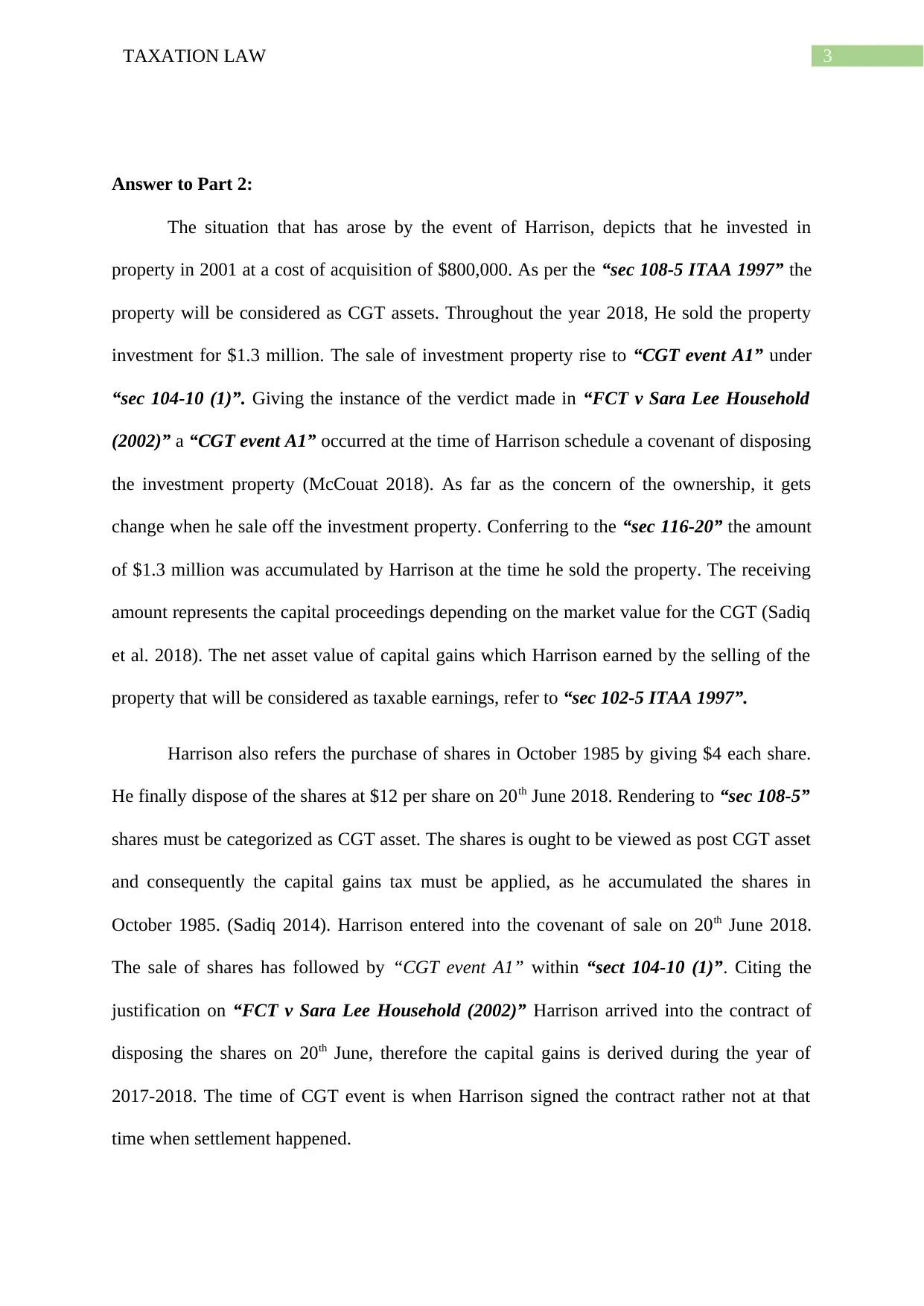
3TAXATION LAW
Answer to Part 2:
The situation that has arose by the event of Harrison, depicts that he invested in
property in 2001 at a cost of acquisition of $800,000. As per the “sec 108-5 ITAA 1997” the
property will be considered as CGT assets. Throughout the year 2018, He sold the property
investment for $1.3 million. The sale of investment property rise to “CGT event A1” under
“sec 104-10 (1)”. Giving the instance of the verdict made in “FCT v Sara Lee Household
(2002)” a “CGT event A1” occurred at the time of Harrison schedule a covenant of disposing
the investment property (McCouat 2018). As far as the concern of the ownership, it gets
change when he sale off the investment property. Conferring to the “sec 116-20” the amount
of $1.3 million was accumulated by Harrison at the time he sold the property. The receiving
amount represents the capital proceedings depending on the market value for the CGT (Sadiq
et al. 2018). The net asset value of capital gains which Harrison earned by the selling of the
property that will be considered as taxable earnings, refer to “sec 102-5 ITAA 1997”.
Harrison also refers the purchase of shares in October 1985 by giving $4 each share.
He finally dispose of the shares at $12 per share on 20th June 2018. Rendering to “sec 108-5”
shares must be categorized as CGT asset. The shares is ought to be viewed as post CGT asset
and consequently the capital gains tax must be applied, as he accumulated the shares in
October 1985. (Sadiq 2014). Harrison entered into the covenant of sale on 20th June 2018.
The sale of shares has followed by “CGT event A1” within “sect 104-10 (1)”. Citing the
justification on “FCT v Sara Lee Household (2002)” Harrison arrived into the contract of
disposing the shares on 20th June, therefore the capital gains is derived during the year of
2017-2018. The time of CGT event is when Harrison signed the contract rather not at that
time when settlement happened.
Answer to Part 2:
The situation that has arose by the event of Harrison, depicts that he invested in
property in 2001 at a cost of acquisition of $800,000. As per the “sec 108-5 ITAA 1997” the
property will be considered as CGT assets. Throughout the year 2018, He sold the property
investment for $1.3 million. The sale of investment property rise to “CGT event A1” under
“sec 104-10 (1)”. Giving the instance of the verdict made in “FCT v Sara Lee Household
(2002)” a “CGT event A1” occurred at the time of Harrison schedule a covenant of disposing
the investment property (McCouat 2018). As far as the concern of the ownership, it gets
change when he sale off the investment property. Conferring to the “sec 116-20” the amount
of $1.3 million was accumulated by Harrison at the time he sold the property. The receiving
amount represents the capital proceedings depending on the market value for the CGT (Sadiq
et al. 2018). The net asset value of capital gains which Harrison earned by the selling of the
property that will be considered as taxable earnings, refer to “sec 102-5 ITAA 1997”.
Harrison also refers the purchase of shares in October 1985 by giving $4 each share.
He finally dispose of the shares at $12 per share on 20th June 2018. Rendering to “sec 108-5”
shares must be categorized as CGT asset. The shares is ought to be viewed as post CGT asset
and consequently the capital gains tax must be applied, as he accumulated the shares in
October 1985. (Sadiq 2014). Harrison entered into the covenant of sale on 20th June 2018.
The sale of shares has followed by “CGT event A1” within “sect 104-10 (1)”. Citing the
justification on “FCT v Sara Lee Household (2002)” Harrison arrived into the contract of
disposing the shares on 20th June, therefore the capital gains is derived during the year of
2017-2018. The time of CGT event is when Harrison signed the contract rather not at that
time when settlement happened.
Secure Best Marks with AI Grader
Need help grading? Try our AI Grader for instant feedback on your assignments.
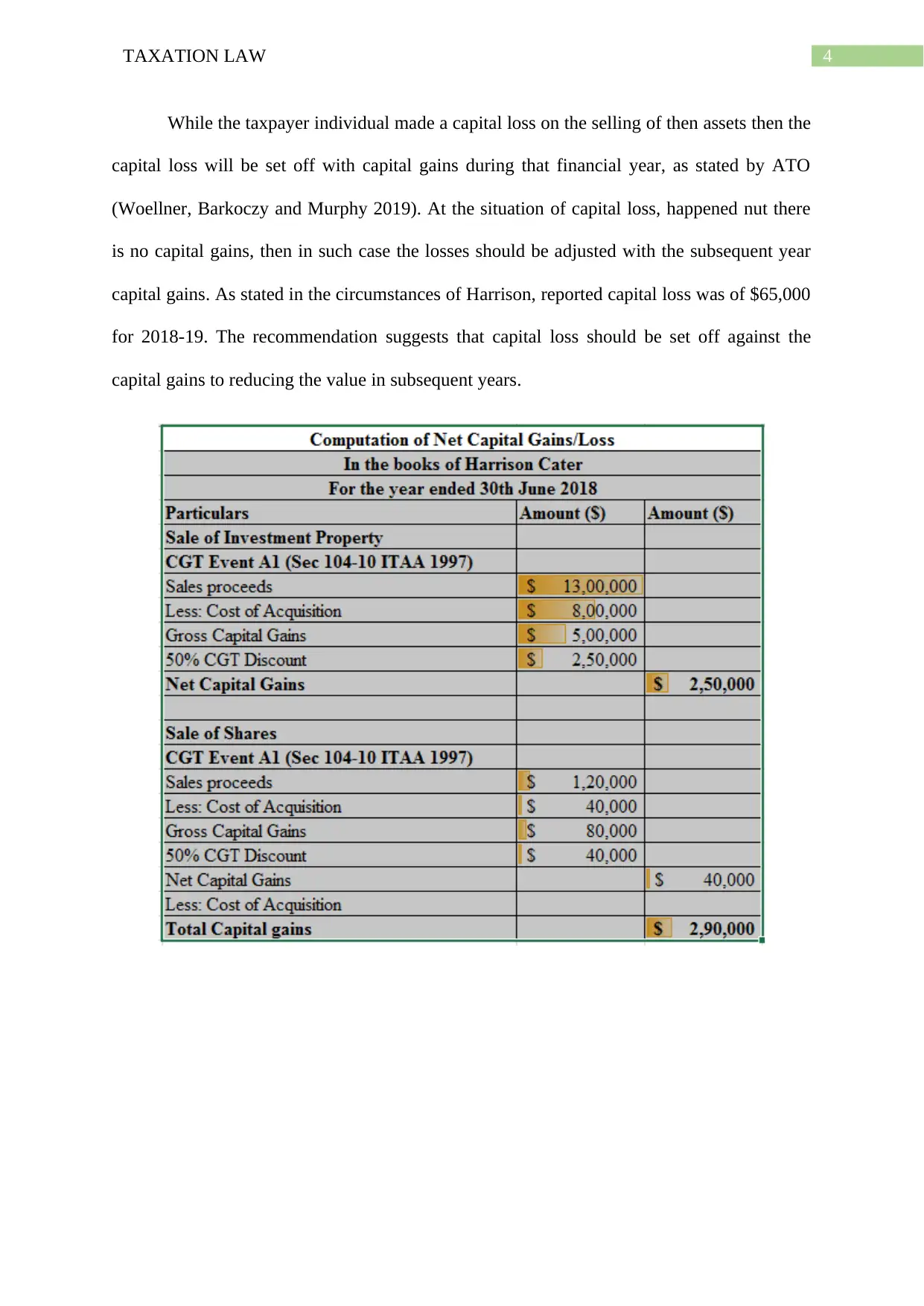
4TAXATION LAW
While the taxpayer individual made a capital loss on the selling of then assets then the
capital loss will be set off with capital gains during that financial year, as stated by ATO
(Woellner, Barkoczy and Murphy 2019). At the situation of capital loss, happened nut there
is no capital gains, then in such case the losses should be adjusted with the subsequent year
capital gains. As stated in the circumstances of Harrison, reported capital loss was of $65,000
for 2018-19. The recommendation suggests that capital loss should be set off against the
capital gains to reducing the value in subsequent years.
While the taxpayer individual made a capital loss on the selling of then assets then the
capital loss will be set off with capital gains during that financial year, as stated by ATO
(Woellner, Barkoczy and Murphy 2019). At the situation of capital loss, happened nut there
is no capital gains, then in such case the losses should be adjusted with the subsequent year
capital gains. As stated in the circumstances of Harrison, reported capital loss was of $65,000
for 2018-19. The recommendation suggests that capital loss should be set off against the
capital gains to reducing the value in subsequent years.
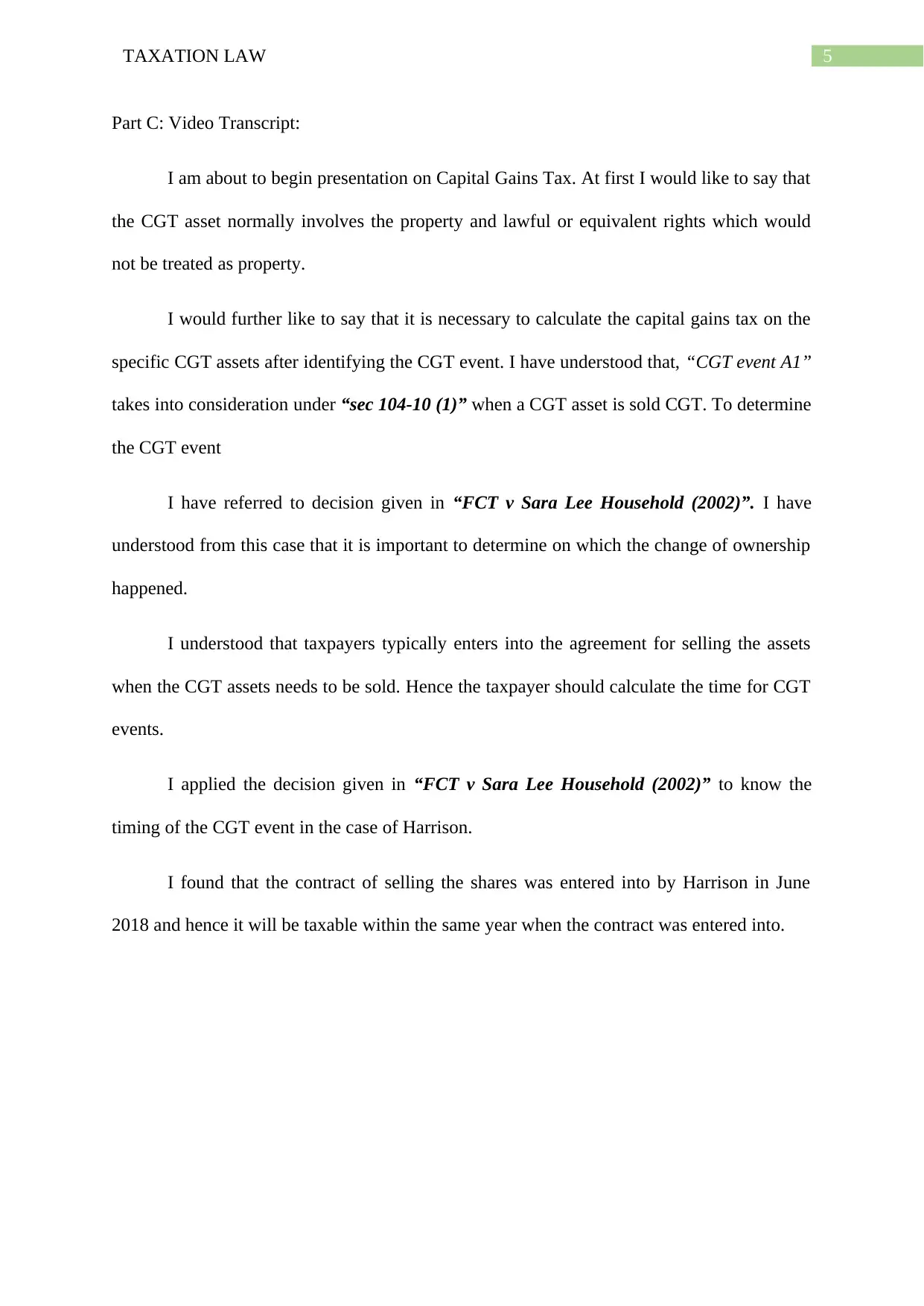
5TAXATION LAW
Part C: Video Transcript:
I am about to begin presentation on Capital Gains Tax. At first I would like to say that
the CGT asset normally involves the property and lawful or equivalent rights which would
not be treated as property.
I would further like to say that it is necessary to calculate the capital gains tax on the
specific CGT assets after identifying the CGT event. I have understood that, “CGT event A1”
takes into consideration under “sec 104-10 (1)” when a CGT asset is sold CGT. To determine
the CGT event
I have referred to decision given in “FCT v Sara Lee Household (2002)”. I have
understood from this case that it is important to determine on which the change of ownership
happened.
I understood that taxpayers typically enters into the agreement for selling the assets
when the CGT assets needs to be sold. Hence the taxpayer should calculate the time for CGT
events.
I applied the decision given in “FCT v Sara Lee Household (2002)” to know the
timing of the CGT event in the case of Harrison.
I found that the contract of selling the shares was entered into by Harrison in June
2018 and hence it will be taxable within the same year when the contract was entered into.
Part C: Video Transcript:
I am about to begin presentation on Capital Gains Tax. At first I would like to say that
the CGT asset normally involves the property and lawful or equivalent rights which would
not be treated as property.
I would further like to say that it is necessary to calculate the capital gains tax on the
specific CGT assets after identifying the CGT event. I have understood that, “CGT event A1”
takes into consideration under “sec 104-10 (1)” when a CGT asset is sold CGT. To determine
the CGT event
I have referred to decision given in “FCT v Sara Lee Household (2002)”. I have
understood from this case that it is important to determine on which the change of ownership
happened.
I understood that taxpayers typically enters into the agreement for selling the assets
when the CGT assets needs to be sold. Hence the taxpayer should calculate the time for CGT
events.
I applied the decision given in “FCT v Sara Lee Household (2002)” to know the
timing of the CGT event in the case of Harrison.
I found that the contract of selling the shares was entered into by Harrison in June
2018 and hence it will be taxable within the same year when the contract was entered into.
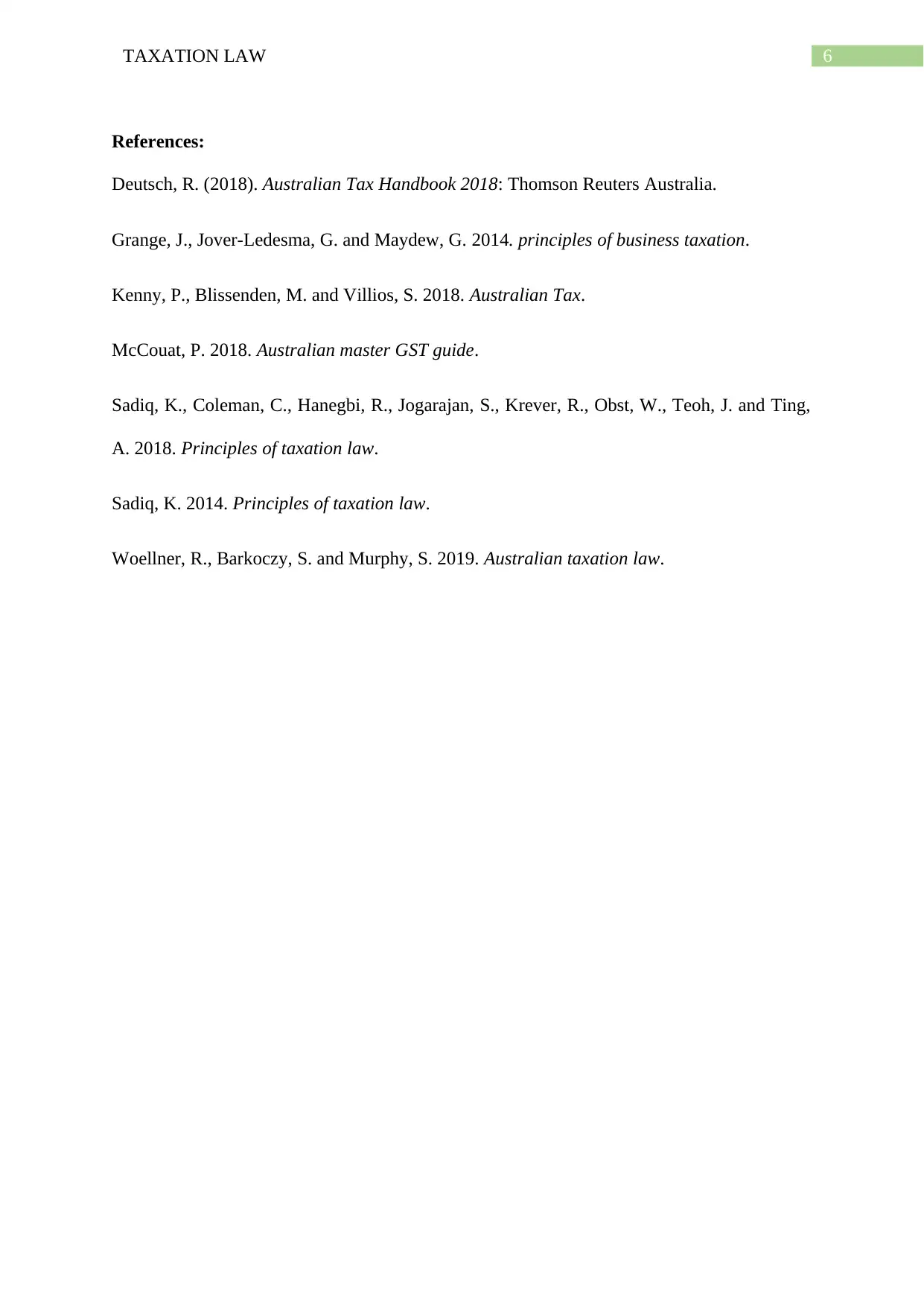
6TAXATION LAW
References:
Deutsch, R. (2018). Australian Tax Handbook 2018: Thomson Reuters Australia.
Grange, J., Jover-Ledesma, G. and Maydew, G. 2014. principles of business taxation.
Kenny, P., Blissenden, M. and Villios, S. 2018. Australian Tax.
McCouat, P. 2018. Australian master GST guide.
Sadiq, K., Coleman, C., Hanegbi, R., Jogarajan, S., Krever, R., Obst, W., Teoh, J. and Ting,
A. 2018. Principles of taxation law.
Sadiq, K. 2014. Principles of taxation law.
Woellner, R., Barkoczy, S. and Murphy, S. 2019. Australian taxation law.
References:
Deutsch, R. (2018). Australian Tax Handbook 2018: Thomson Reuters Australia.
Grange, J., Jover-Ledesma, G. and Maydew, G. 2014. principles of business taxation.
Kenny, P., Blissenden, M. and Villios, S. 2018. Australian Tax.
McCouat, P. 2018. Australian master GST guide.
Sadiq, K., Coleman, C., Hanegbi, R., Jogarajan, S., Krever, R., Obst, W., Teoh, J. and Ting,
A. 2018. Principles of taxation law.
Sadiq, K. 2014. Principles of taxation law.
Woellner, R., Barkoczy, S. and Murphy, S. 2019. Australian taxation law.
1 out of 7
Related Documents
Your All-in-One AI-Powered Toolkit for Academic Success.
+13062052269
info@desklib.com
Available 24*7 on WhatsApp / Email
![[object Object]](/_next/static/media/star-bottom.7253800d.svg)
Unlock your academic potential
© 2024 | Zucol Services PVT LTD | All rights reserved.





